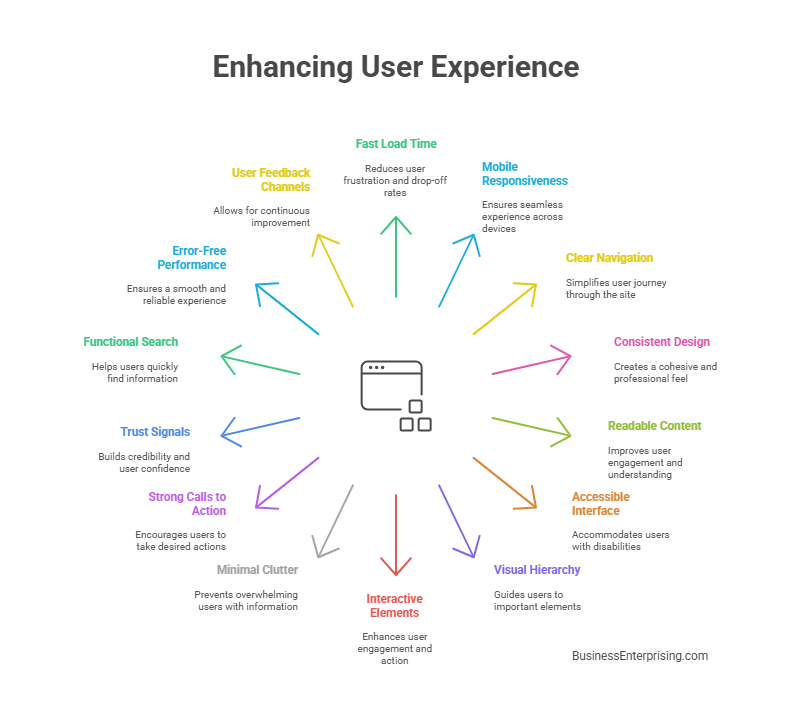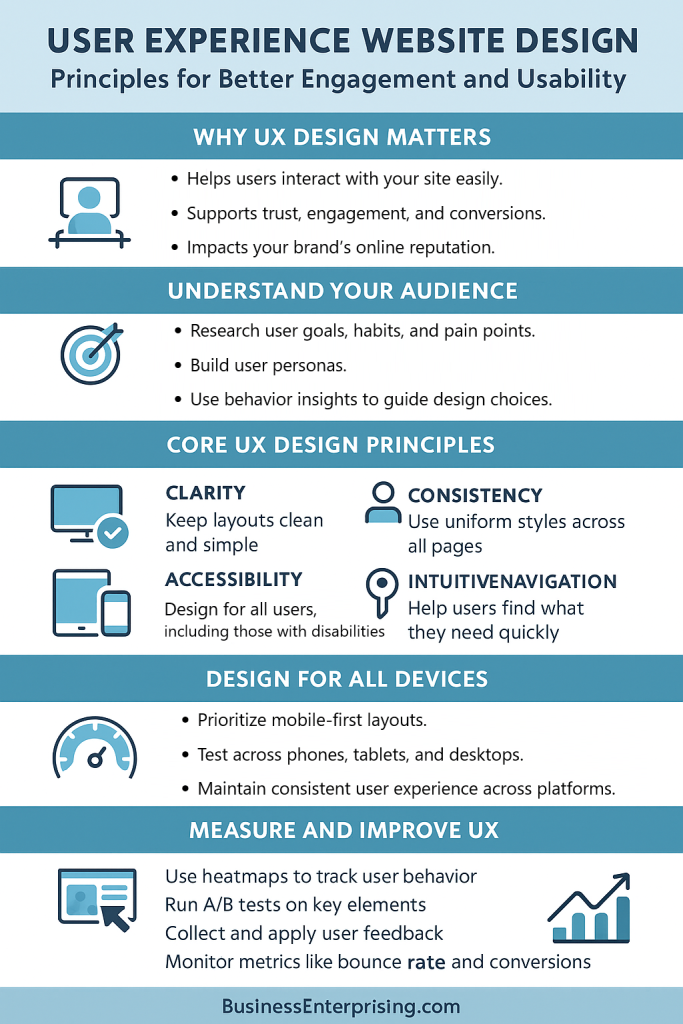
However, if your website feels confusing or slow, visitors will likely leave. Therefore, your design needs to support clear communication and easy navigation. Additionally, every part of your layout should guide users toward the actions you want them to take.
Also, good user experience goes beyond appearance. It includes structure, performance, and functionality. You need to consider how your site works on different devices and how fast it loads. These elements directly affect how users feel about your business.
Understanding user behavior and expectations helps you make better design choices. When you prioritize their needs, your site becomes easier to use. As a result, your conversions improve, and your reputation grows.
Finally, user experience should never be an afterthought. It should guide your decisions from the start. A well-designed website supports your goals, helps your customers, and keeps people coming back.
The Importance of User Experience in Web Design
User experience matters more than you might think when it comes to website design. A poorly designed site frustrates visitors and drives them away. On the other hand, a smooth experience keeps them engaged and encourages action.
Additionally, people form opinions about your business quickly. Therefore, your website must be easy to use and visually clear from the first click. A slow or cluttered layout leads many users to leave without taking further steps. However, a well-designed site makes a positive impression and builds trust.
User experience website design plays a key role in shaping how people interact with your brand. If your site loads fast, is easy to navigate, and offers value, people are more likely to return. As a result, your bounce rate goes down, and your conversion rate often goes up.
Also, good UX design supports your business goals. When users find what they need without frustration, they stay longer and explore more pages. This often leads to more inquiries, purchases, or sign-ups depending on your goals. Therefore, better UX contributes directly to business performance.
Finally, think of your website as a tool for communication. It reflects your business before you ever speak to a customer. If the experience feels professional, the visitor assumes your business operates professionally too.
Understanding Your Audience’s Needs and Behavior
Understanding what your users want is one of the smartest things you can do when planning your website. If you guess, you’ll likely miss the mark. However, when you study real user behavior, you gain clear insight into what works.
Start by identifying your audience. Therefore, build user personas based on age, goals, habits, and challenges. These profiles give you a better picture of who you’re designing for. Additionally, think about what problems your users are trying to solve. Knowing their pain points helps you provide direct, useful solutions.
Also, consider how your users typically behave online. Some may prefer mobile browsing, while others want detailed product comparisons. When you understand these habits, you can design layouts and features that meet those expectations. This makes the entire experience feel more intuitive.
User experience website design works best when it’s based on real needs, not assumptions. For example, if users struggle to find contact information, put it in a more visible spot. If they want quick answers, make your site easy to search or browse.
Finally, check your work by watching how people interact with your site. Tools like heatmaps or session recordings can reveal where users get stuck. With this feedback, you can continue refining your design over time to better serve your audience.
Principles of Effective UX Design
Effective user experience starts with clear design choices. When users understand where to go and what to do, they feel more confident. Therefore, clarity should guide everything from your layout to your calls to action.
Additionally, consistency helps users move through your site without confusion. Use the same colors, fonts, and button styles throughout each page. If every section looks different, visitors may feel lost. However, a uniform design creates a smooth and familiar experience.
You should also think about accessibility. Make sure your site works for everyone, including people with disabilities. Use readable fonts, proper contrast, and keyboard-friendly navigation. These small adjustments make a big difference in how your site performs for all users.
Responsiveness is another key factor. As more people browse on mobile devices, your site must work well on every screen size. Therefore, test your design on phones, tablets, and desktops. If your layout breaks or content doesn’t load, users will likely leave.
Intuitive navigation is equally important. Users should not guess where to click or how to find information. Instead, create clear menus, logical page structures, and helpful links. This approach reduces frustration and keeps people engaged.
Ultimately, user experience website design relies on your ability to think like your users. When you focus on their needs, your design becomes more effective. The easier it is to use your site, the more likely people will trust and return to it.
Designing for Mobile and Cross-Device Usability
Mobile users now make up a large part of your website traffic. Therefore, designing with mobile in mind is no longer optional. If your site works poorly on a phone, people will leave before they engage.
Mobile-first design means you start with small screens and scale up. This approach helps you prioritize important content and simplify layout. Additionally, it forces you to focus on what really matters to your users. As a result, you often create a cleaner and more focused design overall.
However, you still need to think beyond phones. People use tablets, laptops, and desktops to browse your site too. Your design must adapt across all devices. Therefore, use responsive layouts, flexible grids, and scalable text and images. These tools help your site look and function properly no matter what device someone uses.
Also, remember that navigation works differently on smaller screens. You may need to use a mobile-friendly menu or adjust button sizes. Touch-friendly design makes it easier for users to interact with your site without frustration.
User experience website design must be flexible, not fixed. Devices and screen sizes will continue to change. When you test your site on multiple devices, you catch problems early. Additionally, you show users that your business values their time and attention.
Finally, consistency matters across all devices. Your branding, messaging, and experience should feel the same everywhere. If your site feels disjointed, users may get confused or lose trust.
How Page Speed and Performance Impact UX
Page speed affects how people experience your website from the moment it loads. If your site loads slowly, users may leave quickly. Most people won’t wait long for content to appear, even if it’s helpful or well-designed.
Additionally, slow websites frustrate users and reduce engagement. Long wait times interrupt the flow of browsing and damage trust in your brand. However, when your site loads quickly, visitors stay longer and are more likely to take action.
Therefore, you should focus on streamlining your site’s performance. Start by compressing large image files that slow things down. Also, use file formats that balance quality and speed. Optimized images improve load times without sacrificing appearance.
Clean code plays a role too. When your code is bloated or outdated, it creates unnecessary delays. Developers should regularly review and simplify scripts, plugins, and frameworks. These changes help your site run more smoothly across all devices.
User experience website design works best when performance supports usability. If your layout looks great but loads slowly, users won’t stick around to enjoy it. Additionally, fast websites perform better in search rankings, giving you another edge over competitors.
Finally, test your site often to catch speed issues early. Use real device testing, not just simulators. As your content grows, keep checking how changes affect load times. A fast and responsive website builds confidence and keeps users coming back.
Measuring and Improving UX Over Time
User experience improves when you treat it as an ongoing process, not a one-time task. Your website needs regular review. Therefore, use real data to guide your design updates and avoid relying on guesswork.
Start by watching how users interact with your site. Heatmaps can show where people click, scroll, or get stuck. Additionally, this tool helps you identify areas that need better visibility or simpler design. If users ignore certain sections, you may need to adjust the layout or messaging.
A/B testing is another effective method. It lets you compare two design choices side by side. For example, you can test two call-to-action buttons or different menu styles. Then, use performance data to decide which one works best. This helps you improve outcomes without relying on assumptions.
User feedback also plays a major role. Encourage visitors to leave comments about their experience. However, don’t wait for complaints. Instead, actively ask for feedback through short surveys or quick rating tools. Even a few responses can reveal useful patterns.
User experience website design depends on your ability to adapt over time. What worked last year might feel outdated today. Therefore, keep testing, measuring, and adjusting. The more you fine-tune your design, the more usable your site becomes.
Finally, track key metrics like bounce rate, time on site, and conversion rate. When you connect design updates to results, you’ll learn which changes have the biggest impact. This kind of insight supports smarter decisions and a better overall experience.
Conclusion
User experience is not just about looks. It’s about how your site functions and how it feels to your visitors. Therefore, every part of your design should serve a clear purpose. When users can find what they need quickly, they stay longer and take action.
Additionally, user experience website design builds trust. A clean layout, fast load times, and smooth navigation show that your business is reliable. However, when your site feels confusing or outdated, users may question your professionalism.
You should think of your website as an ongoing project. As your audience grows or shifts, your site should evolve too. Therefore, keep testing what works and adjusting what doesn’t. Use real feedback and data to guide your updates over time.
Also, remember that small improvements make a big difference. A shorter form, a clearer button, or a faster page load can improve user behavior. These changes can lead to more conversions, better engagement, and stronger customer relationships.
Finally, your site should feel like a direct extension of your business. The easier it is for users to interact, the more likely they are to trust and return. When you focus on function, clarity, and responsiveness, you support every part of your online presence.



